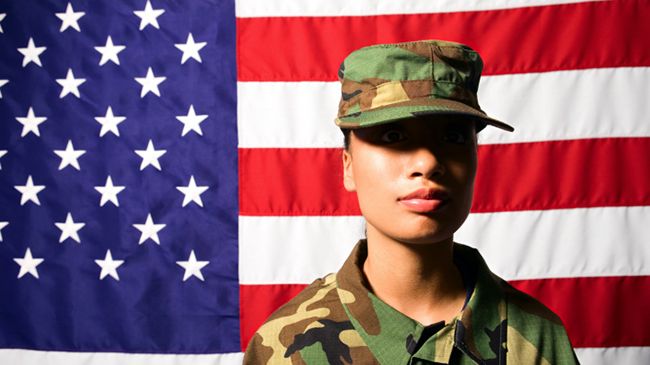
The Army Regulation 670-1 from March 31, 2014 states that hairstyles had to comply to the following:
- Cornrows: “When worn, cornrows must be of uniform dimension, small in diameter (approximately 1⁄4 inch”>, show no more than 1/8 inch of scalp between the cornrows and must be tightly rolled or braided to present a neat, professional, well-groomed appearance. Cornrows must start at the front of the head and continue in one direction in a straight line and end at a consistent location of the head. Only one cornrow style (braided or rolled”> may be worn at one time.”
- Twists: “Twists are defined as twisting two distinct strands of hair around one another to create a twisted rope-like appearance. Although some twists may be temporary, and can be easily untwisted, they are unauthorized (except for French twists”>. This includes twists formed against the scalp or worn in a free-hanging style.”
- Afros: The document does not specifically state anything about afros but it does address length, which is undermined if you do not understand the concept of shrinkage or the volume of curly and coily or natural hair. “Short hair may be no longer than 1/4 inch from scalp unless due to a medical conditioner or injury…Medium hair is defined as hair length that does not extend beyond the lower edge of the collar (in uniform”>, and extends more than 1 inch from the scalp…No portion of the bulk of the hair, as measured from the scalp, will exceed 2 inches…Long hair is defined as hair length that extends beyond the lower edge of the collar.”
Due to major outrage and backlash, the policy was reviewed and altered to “increase the size of authorized braids, cornrows and twist; removing the spacing requirement.” Two-strand twists are accepted if they are temporary and must not pass the collar if you are in the Navy. So where does that leave people with locs?
Initially, military officials stated they were going to ban certain hairstyles in order to “maintain uniformity within a military population” and to properly secure equipment, which brings up a good point—and something that most of us know to be true— the “uniformity” that is “acceptable” to many, is straight hair, period.
This very recurring issue comes up in the workplace. Is my curly, coily, or natural hair appropriate for the office? Well, if you go by the previous military policy, it is not. That is the very agenda that they were promoting. This backwards thinking supports the very notion that wearing your natural, textured hair, in which a great proportion includes people of color—and in styles that are uniquely our own—is unacceptable and unprofessional. As if the characteristics people with textured hair and predominately people of color are born with are somehow wrong. Being as though ethnic hair does not grow out straight, this new policy was clearly discriminatory, and thus reversed and rightly so.
So, what is a girl with a TWA to do? What about the girl that can’t quite get her hair into a slick bun just yet? Or, the one with thick long natural hair that enjoys twists? With the previous policy that didn’t have much of a choice, they were told to wear wigs. One lady refused and was slapped with severe disciplinary actions.
“Matted and unkempt” was the term several branches of the military used to describe braids and locs—a blatant display of disrespect based solely on a persons natural appearance. Here’s a thought: what if military personnel with naturally straight hair were told it was unacceptable? They could only wear braids and twists? The outrage would be astronomical. Yet, that is the same exact issue that confronted people of color in the military. Who decided that straight hair is correct or superior and curly, coily, and natural hair are inferior?
A great question to ask here is: why did this policy ever see the light of day in the first place?
Someone, somewhere, sat in a room with a group of people and decided that ethnic hair needed to be straightened or hidden to be appropriate, and they were sorely wrong. If anything, this situation highlights the kinds of discriminatory laws and policies that could be put into action if not contested. What would happen if no one complained? What other policies would go into effect? No one knows, but the main lesson here is this: if something is discriminatory towards anyone, based on how they look or were born, something needs to be said. Silence dangerous. I give kudos to the military for altering this policy, but the fact that it was even put into action in the first place is disturbing.
